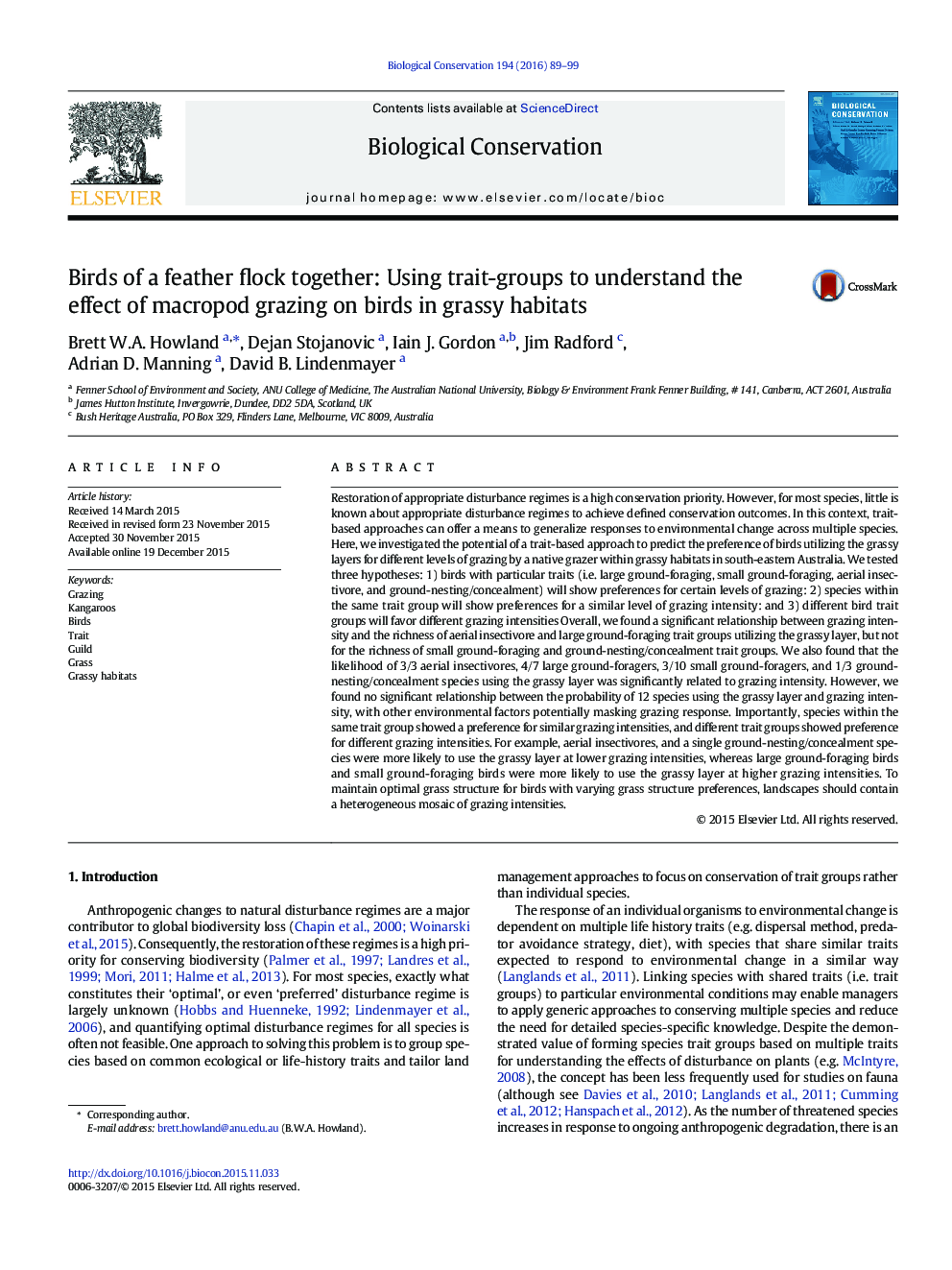| کد مقاله | کد نشریه | سال انتشار | مقاله انگلیسی | نسخه تمام متن |
|---|---|---|---|---|
| 6298786 | 1617907 | 2016 | 11 صفحه PDF | دانلود رایگان |
عنوان انگلیسی مقاله ISI
Birds of a feather flock together: Using trait-groups to understand the effect of macropod grazing on birds in grassy habitats
ترجمه فارسی عنوان
پرندگان یک پرنده با هم: با استفاده از گروه های صفت برای درک اثر چرم ماکوپوود در پرندگان در زیستگاه های چمن
دانلود مقاله + سفارش ترجمه
دانلود مقاله ISI انگلیسی
رایگان برای ایرانیان
کلمات کلیدی
گاو نر. کندرها، پرنده ها، صفت، انجمن چمن، زیستگاههای گیاهی،
ترجمه چکیده
ترمیم رژیم های اختلال مناسب یک اولویت حفاظت بالا است. با این حال، برای اکثر گونه ها، در مورد رژیم های مناسب اختلال برای رسیدن به نتایج حفاظت شده مشخص است. در این زمینه، رویکردهای مبتنی بر صفات می توانند وسیله ای برای تعمیم پاسخ به تغییرات زیست محیطی در میان گونه های مختلف باشند. در اینجا، پتانسیل رویکرد مبتنی بر صفات را برای پیش بینی اولویت پرندگان با استفاده از لایه های علفی برای سطوح مختلف گاو توسط یک شکارچی محلی در زیستگاه های گیاهی در جنوب شرقی استرالیا مورد بررسی قرار دادیم. ما سه فرضیه را بررسی کردیم: 1) پرندگان با ویژگی های خاص (به عنوان مثال، زمین های بزرگ زراعی، زمین زراعی کوچک، حشره کش های هوایی، و زمین لانه سازی / پنهان) ترجیحات را برای سطوح خاصی از چراگاه نشان می دهد: 2) گونه های درون یک گروه صفت ترجیحات مشابهی برای میزان شدت چراغ نشان داده خواهد شد. 3) گروه های مختلف پرنده به ترتیب از میزان تغذیه متفاوت بهره مند می شوند. در کل، ارتباط معنی داری بین شدت چرا و غنی از حشره کش های هوایی و گروه های بزرگ روستایی با استفاده از لایه های گیاهی ، اما نه برای غنای گروه های کوچکی از زمین زراعت و تغذیه زمین / پنهان. همچنین ما دریافتیم که احتمال 3/3 مزارع هوایی، 4/7 بذر بزرگ، 3/10 بذر کوچک و 1/3 گونه لانه سازی / پنهان شدن با استفاده از لایه های چمن دار به طور قابل توجهی به شدت چرا بستگی دارد. با این وجود، ارتباط معنی داری بین احتمال 12 گونه با استفاده از لایه های گیاهی و شدت چرا، و سایر عوامل محیطی که به طور بالقوه پاسخ گری را پوشش می داد، مشاهده نشد. مهمتر از همه، گونه هایی که در یک گروه مشابه قرار داشتند، ترجیح تشدید چربی های مشابه را نشان دادند، و گروه های مختلف صفات ترجیح می دادند تا تنش های مختلف چراغ. به عنوان مثال، آفلاتوکسین های هوایی و گونه های لانه گزینی / پنهانی بیشتر احتمال داشتند که از لایه های گیاهی در تشدید چرت زدن استفاده کنند، در حالیکه پرندگان پرورش دادگاه های بزرگ و پرندگان کوچک پرورش دادار بیشتر احتمال دارد که از لایه های گیاهی در بالاترین سطح استفاده کنند چراغ قوه برای حفظ ساختار چمن مطلوب برای پرندگان با تنظیمات ساختاری مختلف چمن، مناظر باید شامل یک موزاییک ناهمگن از شدت چرت زدن باشد.
موضوعات مرتبط
علوم زیستی و بیوفناوری
علوم کشاورزی و بیولوژیک
بوم شناسی، تکامل، رفتار و سامانه شناسی
چکیده انگلیسی
Restoration of appropriate disturbance regimes is a high conservation priority. However, for most species, little is known about appropriate disturbance regimes to achieve defined conservation outcomes. In this context, trait-based approaches can offer a means to generalize responses to environmental change across multiple species. Here, we investigated the potential of a trait-based approach to predict the preference of birds utilizing the grassy layers for different levels of grazing by a native grazer within grassy habitats in south-eastern Australia. We tested three hypotheses: 1) birds with particular traits (i.e. large ground-foraging, small ground-foraging, aerial insectivore, and ground-nesting/concealment) will show preferences for certain levels of grazing: 2) species within the same trait group will show preferences for a similar level of grazing intensity: and 3) different bird trait groups will favor different grazing intensities Overall, we found a significant relationship between grazing intensity and the richness of aerial insectivore and large ground-foraging trait groups utilizing the grassy layer, but not for the richness of small ground-foraging and ground-nesting/concealment trait groups. We also found that the likelihood of 3/3 aerial insectivores, 4/7 large ground-foragers, 3/10 small ground-foragers, and 1/3 ground-nesting/concealment species using the grassy layer was significantly related to grazing intensity. However, we found no significant relationship between the probability of 12 species using the grassy layer and grazing intensity, with other environmental factors potentially masking grazing response. Importantly, species within the same trait group showed a preference for similar grazing intensities, and different trait groups showed preference for different grazing intensities. For example, aerial insectivores, and a single ground-nesting/concealment species were more likely to use the grassy layer at lower grazing intensities, whereas large ground-foraging birds and small ground-foraging birds were more likely to use the grassy layer at higher grazing intensities. To maintain optimal grass structure for birds with varying grass structure preferences, landscapes should contain a heterogeneous mosaic of grazing intensities.
ناشر
Database: Elsevier - ScienceDirect (ساینس دایرکت)
Journal: Biological Conservation - Volume 194, February 2016, Pages 89-99
Journal: Biological Conservation - Volume 194, February 2016, Pages 89-99
نویسندگان
Brett W.A. Howland, Dejan Stojanovic, Iain J. Gordon, Jim Radford, Adrian D. Manning, David B. Lindenmayer,
